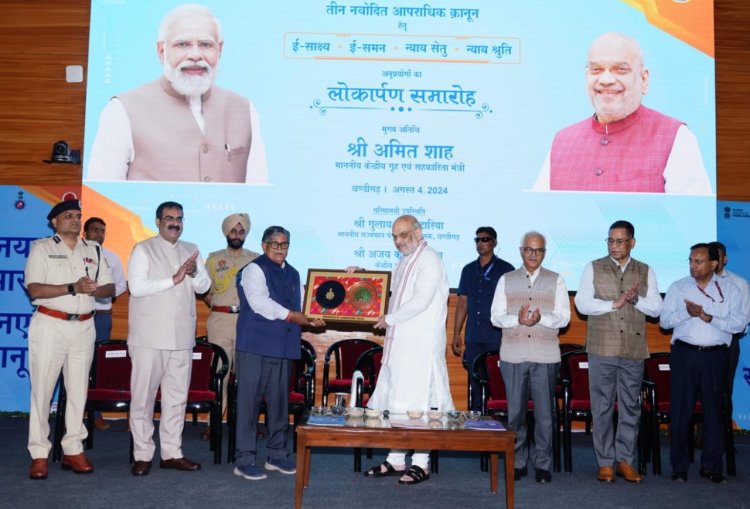Digital Strength to Law Enforcement: Union Minister Amit Shah Launches e-Summon, Nyaya Setu, and More
Intending to expedite the criminal justice system and serve as a catalyst for efficiency and transparency, Union Home Minister Amit Shah has introduced four recently created national apps: e-Sakshya, Nyay Setu, Nyay Shruti, and e-Summons.

Union Home Minister Amit Shah has recently launched four national applications aimed at expediting criminal justice reforms in India. These apps—e-Sakshya, Nyaya Setu, Nyaya Shruti, and e-Summons—are designed to integrate digital strength into law enforcement, enhancing both efficiency and transparency.
Key Highlights of the Initiatives:
- e-Sakshya: Streamlines evidence collection during investigations.
- Nyaya Setu: Facilitates electronic court hearings.
- Nyaya Shruti: Enhances communication between judicial stakeholders.
- e-Summons: Simplifies serving legal documents and notifications.
The integration of technology in the criminal justice system addresses longstanding challenges such as delays and corruption inherent in outdated processes, including the Indian Penal Code (IPC) and Code of Criminal Procedure (CRPC).
This article explores these initiatives, highlighting their objectives, functionalities, and the pivotal role technology plays in modernizing India's criminal justice landscape. Understanding these advancements provides insight into how they can reshape perceptions and improve operational effectiveness for law enforcement agencies across the country.
The Need for Criminal Justice Reforms in India
The current criminal justice system in India faces significant challenges, including:
- Delays: Lengthy trial processes often lead to prolonged suffering for victims and accused alike.
- Corruption: Malpractices within law enforcement undermine public trust and hinder fair justice delivery.
Addressing these issues requires the introduction of new criminal laws in India. Outdated legislation, such as the Indian Penal Code 1860 and the Code of Criminal Procedure 1973, fails to meet contemporary legal needs. The reforms aim to close gaps that allow for inefficiency and lack of transparency.
Key reasons for implementing new laws include:
- Ensuring timely justice delivery
- Protecting citizen rights through clearer provisions
- Adapting to evolving societal norms and values
Technology plays a crucial role in this transformation. Digital solutions can enhance the efficiency and transparency of law enforcement processes. For instance, apps like Nyaya Shruti facilitate better communication among stakeholders, ensuring that relevant information is shared promptly. This integration of technology not only streamlines operations but also fosters an environment of accountability within the criminal justice framework.

Overview of New Criminal Laws and Their Objectives
The introduction of three pivotal laws marks a significant shift in India's criminal justice landscape:
1. Bharatiya Nyaya Sanhita 2023 (BNS)
This law aims to replace the outdated Indian Penal Code of 1860. Its primary goal is to ensure timely justice delivery, particularly addressing heinous crimes such as mob lynching. By modernizing definitions and penalties, BNS intends to enhance the deterrent effect of the law.
2. Bharatiya Nagarik Suraksha Sanhita 2023 (BNSS)
Replacing the Code of Criminal Procedure 1973, BNSS focuses on improving police procedures and safeguarding citizen rights. One of its key objectives is to streamline investigation processes and ensure that victims' voices are prioritized within the legal framework.
3. Bharatiya Sakshya Adhiniyam 2023 (BSA)
This law updates the Indian Evidence Act of 1872. It introduces enhancements related to evidence admissibility, emphasizing the role of forensic science in judicial proceedings. The BSA aims to fortify cases through reliable evidence gathering methods while ensuring fair trials.
Each of these new criminal laws represents a concerted effort to address long-standing issues in the justice system while placing a strong emphasis on protecting citizen rights and ensuring efficient law enforcement processes.
Key Features of Bharatiya Nyaya Sanhita 2023 (BNS)
The Bharatiya Nyaya Sanhita 2023 (BNS) introduces significant changes, particularly in its approach to heinous crimes. Notable features include:
1. IPC Replacement
The BNS replaces the outdated Indian Penal Code (IPC) of 1860, modernizing legal definitions and provisions relevant to contemporary society.
2. Provisions Against Mob Lynching
One of the standout elements is the explicit criminalization of mob lynching. This aims to deter such violence and ensures that perpetrators face stringent penalties.
In terms of impact on police investigations and prosecutions:
- Enhanced evidence collection methods are emphasized, facilitating more efficient documentation during investigations.
- Investigating officers are now empowered to gather evidence through advanced techniques, including digital documentation.
- The integration of forensic science into investigations is prioritized, ensuring that physical evidence is accurately collected and analyzed.
These reforms aim to streamline processes, protect citizen rights, and enhance the overall effectiveness of the criminal justice system in India.
Enhancements Introduced by Bharatiya Nagarik Suraksha Sanhita 2023 (BNSS)
The Bharatiya Nagarik Suraksha Sanhita 2023 (BNSS) brings substantial enhancements aimed at refining police procedures while simultaneously safeguarding citizen rights. Key aspects of this law include:
1. CRPC Replacement
BNSS replaces the outdated Code of Criminal Procedure (CRPC), addressing gaps in current practices and ensuring a more responsive legal framework.
2. Electronic FIR Registration
The introduction of technology into the First Information Report (FIR) process revolutionizes complaint registration. Citizens can now file FIRs electronically, reducing the time and effort previously required for physical submissions.
These advancements serve multiple purposes:
- Streamlined processes lead to quicker response times from law enforcement agencies.
- Enhanced transparency fosters public trust in the criminal justice system.
- Empowerment of citizens through easier access to filing complaints supports their rights.
With these changes, BNSS not only modernizes police operations but also paves the way for a more efficient interaction between law enforcement and the community. As these reforms take effect, they signify a commitment to improving the overall efficiency of the criminal justice system in India.

Advancements Made by Bharatiya Sakshya Adhiniyam 2023 (BSA)
The Bharatiya Sakshya Adhiniyam 2023 (BSA) introduces significant enhancements related to evidence admissibility and gathering processes, aiming to modernize the legal framework surrounding evidence in India. Key features include:
1. Streamlined Evidence Collection
The law emphasizes the importance of reliable evidence collection methods, ensuring that procedures align with contemporary practices. This shift aims to minimize discrepancies and bolster the credibility of gathered evidence.
2. Forensic Science Integration
A notable advancement is the increased role of forensic science in legal proceedings. By endorsing scientific methods, the BSA strengthens cases presented in court, enhancing their reliability. Forensic evidence plays a crucial role in establishing facts, thereby facilitating fair trials.
3. Admissibility of Digital Evidence
The incorporation of digital evidence is crucial in contemporary investigations. The BSA establishes clear guidelines for the admissibility of such evidence, ensuring that technological advancements are fully utilized within the judicial system.
These enhancements signal a commitment to fostering a more efficient and transparent criminal justice system, where the integrity of evidence remains paramount. The implications of these changes are profound, promising a transformation in how cases are prosecuted and adjudicated across India.
National Applications Supporting New Criminal Laws: An Overview
Union Home Minister Amit Shah recently launched two important applications to support the new criminal laws: e-Sakshya and Nyaya Setu. These apps are designed to improve the efficiency of law enforcement and judicial processes in India.
1. e-Sakshya App
This application focuses on digital evidence collection. Investigating officers can now document crime scenes using videos and photographs, making it easier to gather and organize evidence. This method not only improves accuracy but also directly connects collected evidence to chargesheets, significantly enhancing the investigation process.
2. Nyaya Setu App
Designed for electronic court hearings, Nyaya Setu improves communication among various legal stakeholders, including police, lawyers, and judges. By enabling secure sharing of case-related documents and providing real-time updates on case status, this app reduces the need for physical appearances in court, thereby speeding up case processing times.
The launch of these applications is an important step towards modernizing India's criminal justice system. They aim to solve existing problems while promoting transparency and accountability within law enforcement agencies.
1. e-Sakshya App: Transforming Evidence Collection with Technology
The e-Sakshya app is an innovative digital evidence collection app that aims to make the process of gathering and documenting evidence during criminal investigations more efficient. Here are its main features:
Key Features
- Crime Scene Documentation: Officers can use smartphones or drones to take high-quality photos and videos of crime scenes, ensuring accurate and thorough records.
- Witness Statements: The app allows for the direct recording of witness testimonies at the scene, seamlessly connecting statements to relevant evidence.
- Integration with Chargesheets: All collected evidence is automatically linked to the chargesheet, promoting efficiency in case preparation.
Benefits for Investigating Officers
The benefits for investigating officers are substantial:
- Improved Accuracy: Digital documentation of crime scenes enhances the precision of evidence collection, reducing human error associated with traditional methods.
- Time Efficiency: Instant access to digital records speeds up investigations, allowing officers to concentrate on critical tasks instead of paperwork.
- Collaboration Enhancement: Digital files can be easily shared among law enforcement agencies, fostering better coordination.
The adoption of e-Sakshya represents a significant change in how evidence is collected and managed, demonstrating a commitment to modernizing India's criminal justice system through technology.
2. Nyaya Setu App: Enhancing Coordination among Legal Stakeholders via Technology
The Nyaya Setu app is an important electronic court hearing app created to make communication easier between different legal parties, such as police, lawyers, and judges. This new technology makes it possible to:
- Get instant updates on case statuses, so everyone involved can stay informed and active throughout the legal process.
- Share documents securely, which reduces the chances of misunderstandings and improves teamwork among legal experts.
Impact on Case Processing Times
One of the biggest effects of Nyaya Setu is on how long it takes to process cases. By reducing the need for in-person appearances at courts, this app allows legal proceedings to happen more quickly. Investigating officers can submit necessary documents and updates online, which helps in:
- Reducing overcrowding in courtrooms
- Speeding up the overall schedule for hearings
With greater efficiency and better coordination among all parties involved, the Nyaya Setu app not only helps deliver justice on time but also creates a more open legal system. The use of technology in judicial processes is a significant step forward in modernizing India's criminal justice system.
Implementation Strategy for New Laws and Apps Across India Starting July 1st, 2024
The rollout plan for new laws and apps focuses on a structured timeline, ensuring effective implementation across the country. Key milestones during the implementation phase include:
- July 1, 2024: Official launch of the Bharatiya Nyaya Sanhita 2023, Bharatiya Nagarik Suraksha Sanhita 2023, and Bharatiya Sakshya Adhiniyam 2023.
- Chandigarh Implementation: Targeted to achieve full adoption within two months post-launch. This sets a precedent for other states to follow.
To facilitate smooth integration among stakeholders in Chandigarh, several steps are essential:
- Training Programs: Comprehensive workshops for police officers, legal professionals, and judiciary members to familiarize them with the new laws and applications.
- Feedback Mechanisms: Establishing channels for real-time feedback to address challenges faced during the initial phase.
- Technical Support: Providing dedicated IT support teams to assist with app functionalities and resolve technical issues promptly.
This strategic approach aims to ensure that all aspects of law enforcement and judicial processes adapt seamlessly to the new systems, enhancing overall efficiency and transparency as intended by these reforms.
Future Implications of Embracing Digital Tools in Law Enforcement
The introduction of technological advancements within the criminal justice system holds significant promise for its future evolution. The reforms initiated by Union Home Minister Amit Shah may lead to transformative changes in how the system operates. Consider these potential long-term impacts:
1. Improved Public Trust
As technology enhances transparency and accountability, public confidence in law enforcement can increase. Citizens may feel more assured that their rights are being protected and that justice is being served efficiently.
2. Reduced Backlog of Cases
By streamlining processes through applications like e-Sakshya and Nyaya Setu, the judicial system can potentially decrease the number of pending cases. This reduction may lead to faster resolutions and a more responsive legal framework.
Expectations surrounding these reforms are equally critical. Stakeholders anticipate achieving several desired outcomes:
- Enhanced Efficiency: Digital tools are expected to significantly cut down on time spent in investigations, court hearings, and document processing. This efficiency can lead to quicker access to justice for victims and defendants alike.
- Greater Transparency Standards: With systematic tracking of cases and documentation through apps, the potential for corruption diminishes. Enhanced transparency helps ensure that all parties involved understand their roles and responsibilities clearly.
The future of law enforcement lies heavily on technology's role in fostering an adaptive environment. As these digital tools become integrated into daily operations, they will shape the perception of the criminal justice system, making it more accessible and reliable for all citizens. Embracing such innovations suggests a shift towards a more modern approach, one that prioritizes accountability while ensuring justice remains swift and fair.

 Editor
Editor 































